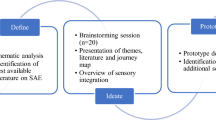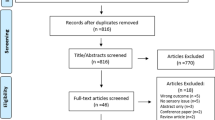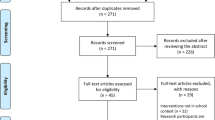Abstract
Children with autism spectrum disorder (ASD) have more frequent use of healthcare services, including visits to the emergency department (ED). Medical care for children with ASD can be adversely affected by the highly stimulating environment of the ED. In this study, we gained insights from stakeholders with lived experience (parents of children with ASD, children with ASD, and ED healthcare providers) to create and implement a sensory equipment kit. The kit was evaluated and iteratively improved based on observations of children using the sensory equipment, satisfaction surveys from their parents, and interviews with healthcare providers in the ED. Findings from this study can be used to guide other EDs in creating their own ASD sensory kit.



Similar content being viewed by others

References
Al Sharif, S., & Ratnapalan, S. (2016). Managing children with autism spectrum disorders in emergency departments. Pediatric Emergency Care, 32(2), 101–103.
Beaver, C. (2011). Designing environments for children and adults on the autism spectrum. Good Autism Practice (GAP), 12(1), 7–11.
Boston Medical Center. (2021). Sensory accommodations. Retrieved from https://www.bmc.org/visiting-us/autism-friendly-initiative/sensory-accommodations.
Brosnan, M., Parsons, S., Good, J., & Yuill, N. (2016). How can participatory design inform the design and development of innovative technologies for autistic communities? Journal of Assistive Technologies, 10(2), 115–120.
Cermak, S. A., Stein Duker, L. I., Williams, M. E., Lane, C. J., Dawson, M. E., Borreson, A. E., & Polido, J. C. (2015). Feasibility of a sensory-adapted dental environment for children with autism. The American Journal of Occupational Therapy, 69(3), 6903220020p1-6903220020p10.
Cineplex. (2022). Sensory friendly screenings. Retrieved from https://www.cineplex.com/Theatres/SensoryFriendly.
Cohen-Silver, J. H., Muskat, B., & Ratnapalan, S. (2014). Autism in the emergency department. Clinical Pediatrics, 53(12), 1134–1138.
Dahlhauser, S., & Frolek, H. (2010). On the go: Sensory kit manuals for families of children with autism spectrum disorders. Occupational Therapy Capstones, 49, 1.
Drake, J., Johnson, N., Stoneck, A. V., Martinez, D. M., & Massey, M. (2012). Evaluation of a coping kit for children with challenging behaviors in a pediatric hospital. Pediatric Nursing, 38(4), 215–221.
Gabriels, R. L., Agnew, J. A., Beresford, C., Morrow, M. A., Mesibov, G., & Wamboldt, M. (2012). Improving psychiatric hospital care for pediatric patients with autism spectrum disorders and intellectual disabilities. Autism Research and Treatment, 2012, 1–7.
Giarelli, E., Nocera, R., Turchi, R., Hardie, T. L., Pagano, R., & Yuan, C. (2014). Sensory stimuli as obstacles to emergency care for children with autism spectrum disorder. Advanced Emergency Nursing Journal, 36(2), 145–163.
Greenhalgh, T., Jackson, C., Shaw, S., & Janamian, T. (2016). Achieving research impact through co-creation in community-based health services: Literature review and case study. The Milbank Quarterly, 94(2), 392–429.
Gurney, J. G., McPheeters, M. L., & Davis, M. M. (2006). Parental report of health conditions and health care use among children with and without autism: National Survey of Children’s Health. Archives of Pediatrics & Adolescent Medicine, 160(8), 825–830.
Harpaz, B.J. (2017). Quiet rooms for autistic children popping up at airports. The Associated Press. Retrieved April 12, 2017, from https://www.ctvnews.ca/lifestyle/quiet-rooms-for-autistic-children-popping-up-at-airports-1.3365703
Hudson, J. (2006). Prescription for success: Supporting children with autism spectrum disorders in the medical environment. Autism Asperger Publishing Company.
Leekam, S. R., Nieto, C., Libby, S. J., Wing, L., & Gould, J. (2007). Describing the sensory abnormalities of children and adults with autism. Journal of Autism and Developmental Disorders, 37(5), 894–910.
Liu, G., Pearl, A. M., Kong, L., Leslie, D. L., & Murray, M. J. (2017). A profile on emergency department utilization in adolescents and young adults with autism spectrum disorders. Journal of Autism and Developmental Disorders, 47(2), 347–358.
Lunsky, Y., Paquette-Smith, M., Weiss, J. A., & Lee, J. (2015). Predictors of emergency service use in adolescents and adults with autism spectrum disorder living with family. Emergency Medicine Journal, 32(10), 787–792.
Marquez, J. J., Downey, A., & Clement, R. (2015). Walking a mile in the user’s shoes: Customer journey mapping as a method to understanding the user experience. Internet Reference Services Quarterly, 20(3–4), 135–150.
Miller, M.E. & Flowers, E. (2016). The difference between a journey map and a service blueprint. Medium. Retrieved from https://blog.practicalservicedesign.com/the-difference-between-a-journey-map-and-a-service-blueprint-31a6e24c4a6c
Mrklas, K. J., Barber, T., Campbell-Scherer, D., Green, L. A., Li, L. C., Marlett, N., & Marshall, D. A. (2020). Co-design in the development of a mobile health app for the management of knee osteoarthritis by patients and physicians: Qualitative study. JMIR mHealth and uHealth, 8(7), e17893.
Muskat, B., Burnham Riosa, P., Nicholas, D. B., Roberts, W., Stoddart, K. P., & Zwaigenbaum, L. (2015). Autism comes to the hospital: The experiences of patients with autism spectrum disorder, their parents and health-care providers at two Canadian paediatric hospitals. Autism, 19(4), 482–490.
Nicholas, D. B., Zwaigenbaum, L., Muskat, B., Craig, W. R., Newton, A. S., Kilmer, C., & Cohen-Silver, J. (2016a). Experiences of emergency department care from the perspective of families in which a child has autism spectrum disorder. Social Work in Health Care, 55(6), 409–426.
Nicholas, D. B., Zwaigenbaum, L., Muskat, B., Craig, W. R., Newton, A. S., Cohen-Silver, J., & Kilmer, C. (2016b). Toward practice advancement in emergency care for children with autism spectrum disorder. Pediatrics, 137(Supplement_2), S205–S211.
O’Hagan, B., Bays-Muchmore, C., Friedman, A., Bartolotti, L., & King, S. (2019). Building an autism-friendly hospital: How we started, what we have accomplished, and where we go from here. Association of University Centers on Disabilities. Retrieved from https://www.aucd.org/template/news.cfm?news_id=14472&id=17.
Scott, I. (2009). Designing learning spaces for children on the autism spectrum. Good Autism Practice (GAP), 10(1), 36–51.
Sesame Place. (2018). Autism center—Activities & theme park resources: Sesame place. Retrieved April 5, from https://sesameplace.com/philadelphia/help/autism-resources/
Sonis, J. D., Aaronson, E. L., Lee, R. Y., Philpotts, L. L., & White, B. A. (2018). Emergency department patient experience: A systematic review of the literature. Journal of Patient Experience, 5(2), 101–106.
Souders, M. C., Freeman, K. G., DePaul, D., & Levy, S. E. (2002). Caring for children and adolescents with autism who require challenging procedures. Pediatric Nursing 28(6), 555–562.
Spinuzzi, C. (2005). The methodology of participatory design. Technical Communication, 52(2), 163–174.
Thomas, D. R. (2006). A general inductive approach for analyzing qualitative evaluation data. American Journal of Evaluation, 27(2), 237–246.
Toronto Symphony Orchestra. (2022). Relaxed performances. Retrieved from https://www.tso.ca/concerts-and-events/relaxed-performances/
Vivanti, G., Kasari, C., Green, J., Mandell, D., Maye, M., & Hudry, K. (2018). Implementing and evaluating early intervention for children with autism: Where are the gaps and what should we do? Autism Research, 11(1), 16–23.
Zwaigenbaum, L., Nicholas, D. B., Muskat, B., Kilmer, C., Newton, A. S., Craig, W. R., Ratnapalan, S., Cohen-Silver, J., Greenblatt, A., Roberts, W., & Sharon, R. (2016). Perspectives of health care providers regarding emergency department care of children and youth with autism spectrum disorder. Journal of Autism and Developmental Disorders, 46(5), 1725–1736.
Acknowledgments
Thank you to the parents who offered their insights. Thank you to Salina Eldon for helping to recruit participants. Thank you to the ED staff and volunteers who championed the kit.
Author information
Authors and Affiliations
Contributions
Authors SL and KS conceived and designed the analysis. SL collected and analyzed the data. SL wrote the paper and KS revised the paper.
Corresponding author
Ethics declarations
Conflict of interest
The authors have no relevant financial or non-financial interests to disclose.
Additional information
Publisher's Note
Springer Nature remains neutral with regard to jurisdictional claims in published maps and institutional affiliations.
Supplementary Information
Below is the link to the electronic supplementary material.
Rights and permissions
About this article
Cite this article
Litwin, S., Sellen, K. Designing a Sensory Kit to Improve the Environment for Children with Autism Spectrum Disorder in the Pediatric Emergency Department. J Autism Dev Disord 53, 3369–3379 (2023). https://doi.org/10.1007/s10803-022-05651-7
Accepted:
Published:
Issue Date:
DOI: https://doi.org/10.1007/s10803-022-05651-7



